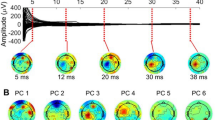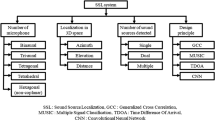Abstract
In this paper, we address the problem of joint acoustic noise and echo cancellations for hands-free systems. The problem of acoustic echo cancelation (AEC) in the presence of background noise is a real challenge for any actual system. In this paper, we propose a new system that combines both processes, i.e. ANC and AEC. In our approach, we propose a two-stages procedure as follows: in the first stage, we propose to use the forward blind source separation (FBSS) structure to cancel the background noise components that is superimposed to the acoustic echo signal in the same environment, this FBSS structure uses the two-channel normalized least mean square (TC-NLMS) adaptive algorithm to cancel the background noise from the primary signal. In the second step, we propose to use an AEC system based on a single channel NLMS (SC-NLMS) algorithm to efficiently suppress the acoustic echo signal. This new combination between the FBSS and the AEC system allows reducing the acoustic echo signal to lower mean square values (MSE) in the permanent regime, this behavior will not be possible without FBSS. The performance properties of the proposed algorithm in such environment (i.e. presence of background plus acoustic echo signals in the same time) is evaluated with competitive algorithm with various objective criteria (ERLE, SegSNR, and GainMSE).












Similar content being viewed by others
References
Al-Kindi, M. J., & Dunlop, J. (1989). Improved adaptive noise cancellation in the presence of signal leakage on the noise reference channel. Signal Processing, 17(3), 241–250.
Beaugeant, C. (1999). Reduction de bruit et controle d’echo pour les applications radiomobiles.
Bendoumia, R., & Djendi, M. (2015). Two-channel variable-step-size forward-and-backward adaptive algorithms for acoustic noise reduction and speech enhancement. Signal Processing, 108, 226–244.
Benesty, J., Amand, F., Gilloire, A., & Grenier, Y. (1995). Adaptive filtering algorithms for stereophonic acoustic echo cancellation. In Proceedings of IEEE 1995 International Conference on Acoustics, Speech, and Signal Processing - Detroit, MI, USA.
Benesty, J., Morgan, D. R., Hall adn, J. L., & Sondhi, M. M. (1999). Synthesised stereo combined with acoustic echo cancellation for desktop conferencing. In Proceedings of ICASSP99, 1999.
Benesty, J., Sondhi, M. M., & Huang, Y. (2008). Adaptive Echo Cancelation for Voice Signals. Springer Handbook of Speech Processing, Chapter 45, (pp.903–927), New York: Springer.
Boll, S. F. (1979). Suppression of acoustic noise in speech using spectral subtraction. IEEE Transactions on Acoustis Speech Signal Processing, 7(2), 113–120.
Boll, S. F., & Pulshipher, D. (1980). Suppression of acoustic noise in speech using two microphone adaptive noise cancellation. IEEE Transactions on Acoustic Speech Signal Processing, 28(6), 752–753.
Bouquin-Jeannès, R. L., Azirani, A. A., & Faucon, G. (1997). Enhancement of speech degraded by coherent and incoherent noise using a cross-spectral estimator. IEEE Transactions on Speech Audio Processing, 5, 484–487.
Bouquin-Jeannès, R. L., & Faucon, G. (1997). How to reduce the noise influence in a joint system developed for echo and noise cancellation. IEE Signal Processing Letters, 4(10), 280–282.
Ciochină, S., Paleologu, C., Benesty, J., & Grant, S. L. (2015). An optimized NLMS algorithm for acoustic echo cancellation. Circuits and Systems (ISSCS), Romania: International Symposium on Signals.
Djendi, M. (2015). New efficient adaptive fast transversal filtering (FTF)-type algorithms for mono and stereophonic acoustic echo cancelation. International Journal of Adaptive Control and Signal Processing, 29, 273–301.
Djendi, M. (2016). An efficient frequency-domain adaptive forward BSS algorithm for acoustic noise reduction and speech quality enhancement. Computers & Electrical Engineering, 52, 12–27.
Djendi, M. (2017). A new two-microphone Gauss-Seidel pseudo affine projection algorithm for speech quality enhancement. International Journal of Adaptive Control Signal Processing, 31, 1–22.
Djendi, M.,Sayoud, A., & Henni, R. (2016) A Dual Forward BSS Based RLS (DFRLS) algorithm for Speech Enhancement and Acoustic Noise Reduction. In Proseedings of International Conference on Engineering and MIS, ICEMIS’2016, At Agadir, Morocco.
Djendi, M., & Scalart, P. (2012) Double pseudo affine projection algorithm for speech enhancement and acoustic noise reduction. In Proceedings of IEEE. EUSIPCO, Romania, Bucharest. vol. 1, pp. 27–31.
Djendi, M., Scalart, P., & Gilloire, A. (2006). Noise cancellation using two closely spaced microphones: experimental study with a specific model and two adaptive algorithms. In Proceedings of IEEE ICASSP, vol. 3, p. 7447.4.
Djendi, M., Scalart, P., & Gilloire, A. (2013). Analysis of two-sensors forward BSS structure with post-filters in the presence of coherent and incoherent noise. Speech Communication, 55(10), 975–987.
Djendi, M., & Zoulikha, M. (2014). New automatic forward and backward blind sources separation algorithms for noise reduction and speech enhancement. Computers & Electrical Engineering, 40, 2072–2088.
Djendi, M., & Zoulikha, M. (2018). A new efficient backward BSS crosstalk-resistant algorithm for automatic blind speech quality enhancement. International Journal of Speech Technology, 21, 1–15.
Ephraim, Y., & Malah, D. (1985). Speech enhancement using a minimum mean-square error log-spectral amplitude estimator. IEEE Transactions on Acoustics Speech and Signal Processing, 33(2), 443–445.
Ghribi, K., Djendi, M., & Berkani, D. (2016). A wavelet-based forward BSS algorithm for acoustic noise reduction and speech enhancement. Applied Acoustics, 105, 55–66.
Gilloire, A., & Vetterli, M. (1992). Adaptive filtering in subbands with critical sampling: Analysis, Experiments, and application to acoustic echo cancellation. IEEE Transactions on Signal Processing, 40(8), 1862–1875.
Guelou, Y., Benamar, A., & Scalart, P. (1996). Analysis of two structures for combined acoustic echo cancellation and noise reduction. Proceedings of IEEE International Conference Acoustic Speech Signal Processing, 2, 637–640.
Hanshi, S. M., Chong, Y. W. Ramadass, S., Naeem, A. N., & Ooi, K. C. (2014) Efficient Acoustic Echo Cancellation Joint with Noise Reduction Framework. In Proceedings of International Conference on Computer, Communication, and Control Technology (I4CT 2014), September 2-4, 2014—Langkawi, Kedah, Malaysia.
Henni, R., Djebari, M., & Djendi, M. (2017). Blind Speech Enhancement and Acoustic Noise Reduction by SFTF Adaptive Algorithm. The 5th International Conference on Electrical Engineering, Boumerdes, Algeria, 2017.
Huang, Y., Bensty, J., & Chen, J. (2006). Acoustic MIMO Signal Processing, (Chapter 8. Acoustic Echo Cancellation And Audio Bridge, pp.185– 213), Springer, 2006.
Huang, Y. A., Luebs, A., Skoglund, J., & Kleijn, W. B. (2016). Globally optimized least-squares post-filtering for microphone array speech enhancement. IEEE International Conference on Acoustics Speech and Signal Processing (ICASSP), 2016, 380–384.
Jeannes, J., Scalart, P., Faucon, G., & Beaugent, C. (2001). Combined noise and echo reduction in hands-free systems: a survey. IEEE Transactions on Speech and Audio Processing, 9(8), 808–820.
Jin, W., Taghizadeh, M. J., Chen, K., & Xiao, W. (2017). Multi-channel noise reduction for hands-free voice communication on mobile phones. International Conference on Acoustics, Speech and Signal Processing (ICASSP), 2017, pp. 506–510.
Kim, D. I., & De Wilde, P. (2000). Performance analysis of the DCT-LMS adaptive filtering algorithm. Signal Processing, 80(7), 1629–1654.
Kim, Y. S., Song, J. H., & Kim, S. K. (2014). Variable step-size affine projection algorithm based on global speech absence probability for adaptive feedback cancellation. Journal of Central South University., 21(2), 646–650.
Kuo, S. M., Gan, W. S. & Asthana, P. (2005). Integrated noise reduction and acoustic echo cancellation in hands-free systems. In Proceedings of 2005 International Symposium on Intelligent Signal Processing and Communication Systems, Hong Kong.
Loizou, P. C. (2017). Speech enhancement: theory and practice (2nd ed.). Taylor & Francis Group: CRC Press.
Martin, R., & Vary, P. (1994). Combined acoustic echo cancellation, dereverberation and noise reduction: a two microphone approach. Annals of Telecommunications, 49, 429–438.
Martin, R., & Vary, P. (1996). Combined acoustic echo control and noise reduction for hands- free telephony-state of the art and perspectives. In EUSIPCO96 (p. 1107)
Park, Y.-S., & Chang, J.-H. (2012). Integrated acoustic echo and background noise suppression technique based on soft decision. Park and Chang EURASIP Journal on Advances in Signal Processing. https://doi.org/10.1186/1687-6180-2012-11.
Park, S. J., Cho, C. G., Lee, C., & Youn, D. H. (2002). Integrated echo and noise canceller for hands-free applications. IEEE Trans Circuits Syst II., 49(3), 186–195.
Pradhan, S. S., & Reddy, V. E. (1999). A new approach to subband adaptive filtering. IEEE Transactions on Signal Processing, 47, 655–664.
Puder, H., & Dreiseitel, P. (2000). Implementation of a hands-free car phone with echo cancellation and noise-dependent loss control. Proceedings of IEEE International Conference Acoustic Speech Signal Processing, 6, 3622–3625.
Sakai, Y., & Tahir Akhtar, M. (2013). The performance of the acoustic echo cancelation using blind source separation to reduce double-talk interference. In Proceedings of International Symposium on Intelligent Signal Processing and Communication Systems, Naha, Japan, 2013.
Sayed, A. H. (2003). Fundamentals of Adaptive Filtering. New York: Wiley.
Sayoud, A., Djendi, M., Medahi, S., & Guessoum, A. (2018). A dual fast NLMS adaptive filtering algorithm for blind speech quality enhancement. Applied Acoustics, 135, 101–110.
Scalart, P., & Filho, J. (1996). Speech enhancement based on a priori signal to noise estimation. Proceedings of International Conference on Acoustic Speech Signal processing, 2, 629–632.
Van Gerven, S., & Van Compernolle, D. (1992). Feed forward and feedback in symmetric adaptive noise canceller: stability analysis in a simplified case. In European signal processing conf. Brussels. Belgium. (pp. 1081–1084).
Van Gerven, S., & Van Compernolle, D. (1995). Signal separation by symmetric adaptive decorrelation: stability, convergence, and uniqueness. IEEE Trans Signal Proc, 74(3), 1602–1612.
Weinstein, E., Feder, M., & Oppenheim, A. V. (1993). Multi-channel signal separation by decorrelation. IEEE Transactions on Speech Audio Processing, 1(4), 405–413.
Widrow, B., & Stearns, S. D. (1985). Adaptive signal processing. Upper Saddle River: Prentice Hall.
Zoulikha, M., Djendi, M., & Guessoum, A. (2017) A Variable Step Size-Forward Blind Source Separation Algorithm for Speech Enhancement. In proceedings of International Conference on Electrical Engineering and Control Applications, ICEECA 2017, Advanced Control Engineering Methods in Electrical Engineering Systems, pp. 479–487.
Author information
Authors and Affiliations
Corresponding author
Additional information
Publisher's Note
Springer Nature remains neutral with regard to jurisdictional claims in published maps and institutional affiliations.
Rights and permissions
About this article
Cite this article
Djendi, M., Henni, R. & Djebari, M. A new adaptive solution based on joint acoustic noise and echo cancellation for hands-free systems. Int J Speech Technol 22, 407–420 (2019). https://doi.org/10.1007/s10772-019-09615-8
Received:
Accepted:
Published:
Issue Date:
DOI: https://doi.org/10.1007/s10772-019-09615-8




